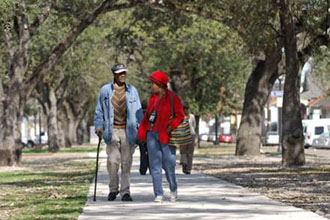Healthy neighborhoods contribute to healthy people

When residents feel their community supports physical activity and healthy eating, they are more likely to have an active, healthy lifestyle, says Keelia O'Malley of Tulane, one of the study's authors. (Photo by Paula Burch-Celentano)
More than 1,200 adults participated in the study's phone survey, developed by the Physical Activity Policy Research Network, a national research network funded by the U.S. Centers for Disease Control and Prevention to study physical activity policies. The findings were published in a special issue of the American Journal of Health Promotion in January.
The survey asked questions to gauge support for physical activity policies in schools, work sites and communities; neighborhood features and amenities related to physical activity and healthy eating; and time spent in physical activity and sedentary behaviors.
Participants reported their weight and height, along with other personal characteristics.
The researchers compared answers from participants living in areas with high vs. low levels of obesity and sedentary behavior.People reported the strongest support for policies in schools, and this opinion did not differ between the two types of counties or parishes. They also expressed support for physical activity policies at work sites and in communities, but those in counties or parishes with low levels of obesity and sedentary behavior had stronger overall support for physical activity policies in communities.
Naomi King Englar is the communications and training coordinator for the Prevention Research Center and the Maternal and Child Health Leadership Training Program at Tulane University.
